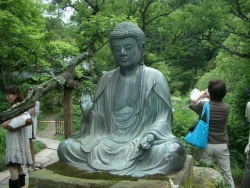Difference between revisions of "Mahaparinirvana"
| Line 2: | Line 2: | ||
The [[Buddhist]] term, "[[Mahaparinirvana]]", meaning "great,{{Wiki|complete}} [[Nirvana]]" is also encountered. The [[word]] "[[Mahaparinirvana]]" usually refers to the [[ultimate]] state of [[Nirvana]] (everlasting, [[highest]] [[peace]] and [[happiness]]) entered by an {{Wiki|Awakened}} {{Wiki|Being}} ([[Buddha]]) or "[[arhat]]" at the moment of {{Wiki|physical}} [[death]], when the [[mundane]] [[skandhas]] (constituent [[elements]] of the ordinary [[body]] and [[mind]]) are shed and only the [[Buddhic]] [[skandhas]] remain (this in [[Mahayana]] [[Buddhism]]). However, it can also refer (in the [[Mahayana]]) to the same inner [[spiritual]] state reached during a [[Buddha]]'s {{Wiki|physical}} [[lifetime]] too. In the [[Mahayana]] [[Buddhist]] [[scripture]] entitled the "[[Mahayana Mahaparinirvana Sutra]]", the [[Buddha]] teaches that unlike "ordinary" [[Nirvana]], "[[Mahaparinirvana]]" is the [[highest]] state or [[realm]] realised by a {{Wiki|perfect}} [[Buddha]], a state in which that [[Buddhic]] [[being]] awakens to "the {{Wiki|Eternal}}, [[Bliss]], the [[Self]], and the {{Wiki|Pure}}". Only in [[Mahaparinirvana]] is this True [[Self]] ("[[atman]]") of the [[Buddha]] said to be fully discernible. | The [[Buddhist]] term, "[[Mahaparinirvana]]", meaning "great,{{Wiki|complete}} [[Nirvana]]" is also encountered. The [[word]] "[[Mahaparinirvana]]" usually refers to the [[ultimate]] state of [[Nirvana]] (everlasting, [[highest]] [[peace]] and [[happiness]]) entered by an {{Wiki|Awakened}} {{Wiki|Being}} ([[Buddha]]) or "[[arhat]]" at the moment of {{Wiki|physical}} [[death]], when the [[mundane]] [[skandhas]] (constituent [[elements]] of the ordinary [[body]] and [[mind]]) are shed and only the [[Buddhic]] [[skandhas]] remain (this in [[Mahayana]] [[Buddhism]]). However, it can also refer (in the [[Mahayana]]) to the same inner [[spiritual]] state reached during a [[Buddha]]'s {{Wiki|physical}} [[lifetime]] too. In the [[Mahayana]] [[Buddhist]] [[scripture]] entitled the "[[Mahayana Mahaparinirvana Sutra]]", the [[Buddha]] teaches that unlike "ordinary" [[Nirvana]], "[[Mahaparinirvana]]" is the [[highest]] state or [[realm]] realised by a {{Wiki|perfect}} [[Buddha]], a state in which that [[Buddhic]] [[being]] awakens to "the {{Wiki|Eternal}}, [[Bliss]], the [[Self]], and the {{Wiki|Pure}}". Only in [[Mahaparinirvana]] is this True [[Self]] ("[[atman]]") of the [[Buddha]] said to be fully discernible. | ||
| − | In [[Buddhism]], [[parinirvana]] ([[Sanskrit]] -- [[Pali]]: [[Parinibbana]] -- {{Wiki|Chinese}}: 般涅槃; {{Wiki|Pinyin}}: bō niè pán) is the final [[nirvana]], usually understood to be within reach only upon the [[death]] of someone who has [[attained]] {{Wiki|complete}} {{Wiki|Awakening}}. It is the [[ultimate]] goal of [[Buddhist]] practice and implies a [[release]] from the cycle of [[deaths]] and [[rebirths]] as well as the [[dissolution]] of all [[worldly]] [[physical]] and [[mental]] [[aggregates]] or [[skandhas]] ([[form]], [[feeling]], [[perception]], [[mental]] [[fabrications]] and [[consciousness]]). | + | In [[Buddhism]], [[parinirvana]] ([[Sanskrit]] -- [[Pali]]: [[Parinibbana]] -- {{Wiki|Chinese}}: [[般涅槃]]; {{Wiki|Pinyin}}: [[bō niè pán]]) is the final [[nirvana]], usually understood to be within reach only upon the [[death]] of someone who has [[attained]] {{Wiki|complete}} {{Wiki|Awakening}}. It is the [[ultimate]] goal of [[Buddhist]] practice and implies a [[release]] from the cycle of [[deaths]] and [[rebirths]] as well as the [[dissolution]] of all [[worldly]] [[physical]] and [[mental]] [[aggregates]] or [[skandhas]] ([[form]], [[feeling]], [[perception]], [[mental]] [[fabrications]] and [[consciousness]]). |
The [[parinirvana]] of [[Gautama]] [[Buddha]] is depicted in the [[Mahaparinibbana Sutta]] and the [[Mahaparinirvana Sutra]]. | The [[parinirvana]] of [[Gautama]] [[Buddha]] is depicted in the [[Mahaparinibbana Sutta]] and the [[Mahaparinirvana Sutra]]. | ||
{{W}} | {{W}} | ||
[[Category:Nirvana]] | [[Category:Nirvana]] | ||
Latest revision as of 09:49, 2 September 2014
The Buddhist term, "Mahaparinirvana", meaning "great,complete Nirvana" is also encountered. The word "Mahaparinirvana" usually refers to the ultimate state of Nirvana (everlasting, highest peace and happiness) entered by an Awakened Being (Buddha) or "arhat" at the moment of physical death, when the mundane skandhas (constituent elements of the ordinary body and mind) are shed and only the Buddhic skandhas remain (this in Mahayana Buddhism). However, it can also refer (in the Mahayana) to the same inner spiritual state reached during a Buddha's physical lifetime too. In the Mahayana Buddhist scripture entitled the "Mahayana Mahaparinirvana Sutra", the Buddha teaches that unlike "ordinary" Nirvana, "Mahaparinirvana" is the highest state or realm realised by a perfect Buddha, a state in which that Buddhic being awakens to "the Eternal, Bliss, the Self, and the Pure". Only in Mahaparinirvana is this True Self ("atman") of the Buddha said to be fully discernible.
In Buddhism, parinirvana (Sanskrit -- Pali: Parinibbana -- Chinese: 般涅槃; Pinyin: bō niè pán) is the final nirvana, usually understood to be within reach only upon the death of someone who has attained complete Awakening. It is the ultimate goal of Buddhist practice and implies a release from the cycle of deaths and rebirths as well as the dissolution of all worldly physical and mental aggregates or skandhas (form, feeling, perception, mental fabrications and consciousness).
The parinirvana of Gautama Buddha is depicted in the Mahaparinibbana Sutta and the Mahaparinirvana Sutra.
